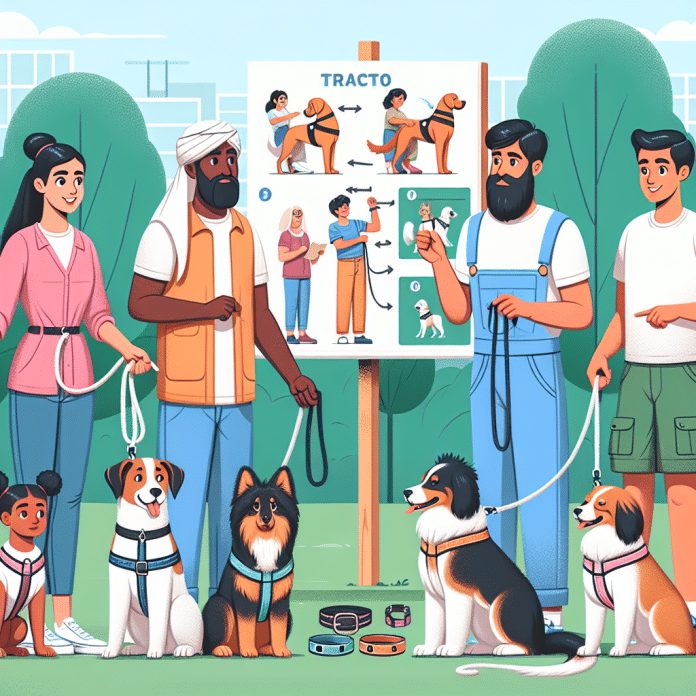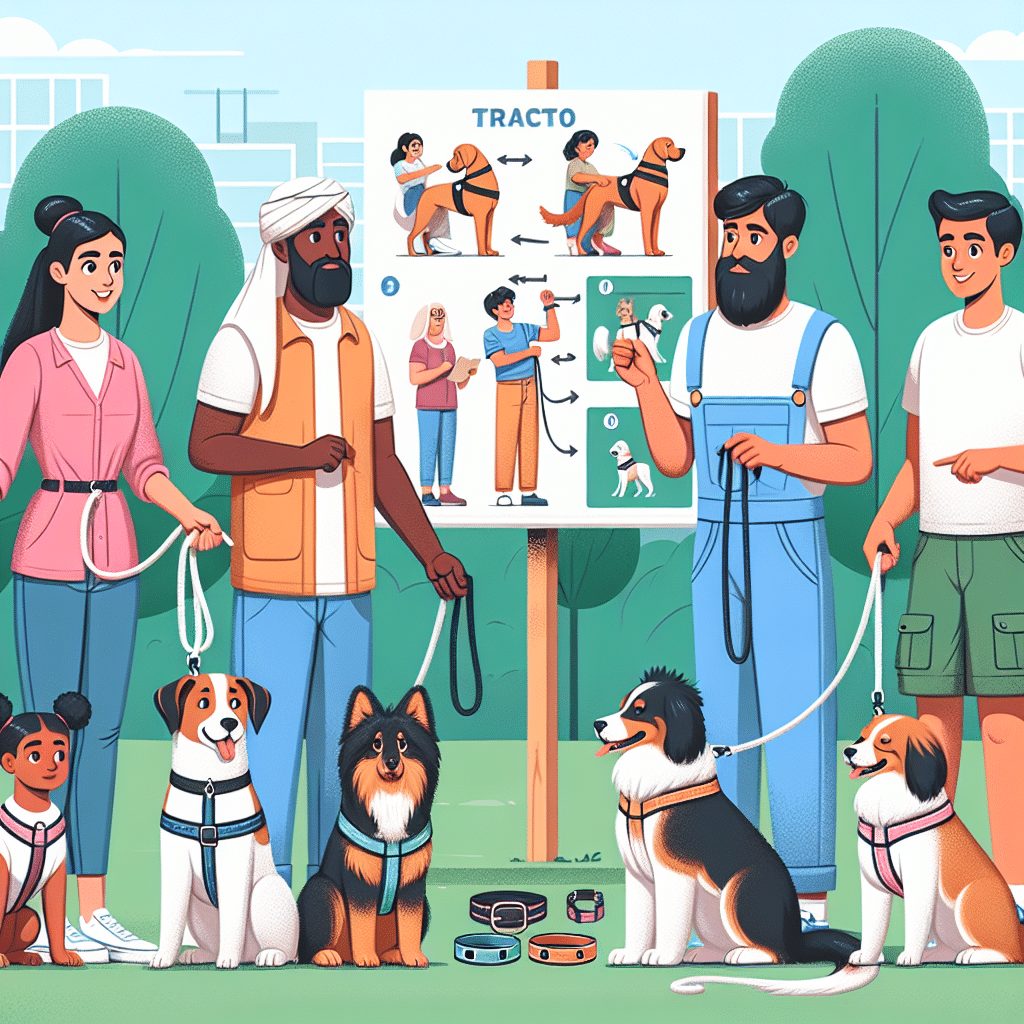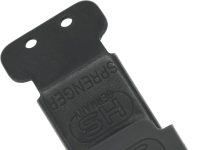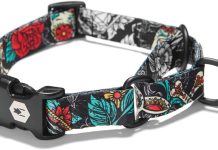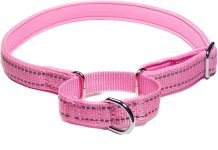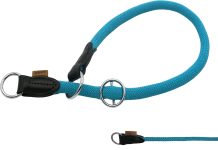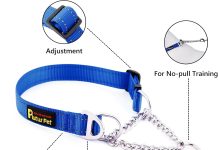If you’ve ever struggled with getting your dog to walk calmly on a harness, you’re not alone. Many dog owners have experienced the frustration of their furry friend pulling, tugging, and just generally making the whole experience of going for a walk quite chaotic. But fear not, because in this article, we’re going to explore some effective techniques that will help you train your dog to walk properly in a harness. From teaching leash manners to using positive reinforcement, you’ll soon be strolling down the street with your well-behaved canine companion. So grab a treat, put on your walking shoes, and let’s get started on this training adventure!
Choosing the Right Harness
Table of Contents
Understanding the Different Types of Harnesses
When it comes to choosing a harness for your dog, it’s important to understand the different types available. There are several options to consider, such as back-clip, front-clip, and step-in harnesses.
Back-clip harnesses attach the leash to the back of the dog, which is a popular choice for small breeds and dogs who have not yet been trained to walk properly on a leash. Front-clip harnesses, on the other hand, have the leash attachment in the front, which helps to discourage pulling and redirect your dog’s attention towards you. Step-in harnesses are designed to be easily put on by having your dog “step” into the harness.
Selecting a Comfortable and Secure Harness
When selecting a harness, it’s crucial to prioritize both comfort and security. Look for harnesses that have adjustable straps to ensure a proper fit for your dog’s size and body shape. The harness should be snug but not too tight, allowing your dog to move freely without chafing or discomfort.
It’s also advisable to choose a harness made of durable and breathable materials. Check for any potential pressure points that might cause irritation or discomfort, such as rough edges or rubbing against your dog’s skin. Taking your dog’s measurements and consulting the sizing chart provided by the manufacturer can be helpful in finding the right fit.
Checking the Fit of the Harness
Once you’ve chosen a harness, it’s essential to check the fit before using it on your dog. Ensure that the harness is properly adjusted to your dog’s body, with enough room for two fingers to comfortably fit between the straps and your dog’s skin.
Pay attention to the chest and neck areas, as these are the most critical points of contact between your dog and the harness. Make sure the straps are neither too loose nor too tight, as both can hinder your dog’s movement or cause discomfort.
Check for any signs of rubbing or chafing during the first few walks with the harness and make the necessary adjustments to achieve a secure and comfortable fit for your furry friend.
Introducing the Harness to Your Dog
Allowing Your Dog to Sniff and Explore the Harness
Before putting the harness on your dog, it’s crucial to give them the opportunity to become familiar with it. Allow your dog to sniff and explore the harness, reinforcing positive associations by incorporating treats or praise.
Place the harness within their reach and let them investigate it at their own pace. This helps your dog associate the harness with positive experiences and reduces any potential fear or reluctance towards wearing it.
Positive Associations with the Harness
To create positive associations with the harness, associate it with enjoyable activities or rewards. For example, you can give your dog a treat every time they see or approach the harness, gradually pairing the presence of the harness with something they enjoy.
Another helpful technique is to feed your dog their meals near the harness or use it as part of their playtime routine. This helps your dog associate the harness with positive experiences and increases their willingness to wear it.
Gradual Introduction to Wearing the Harness
Once your dog is comfortable with the harness, it’s time to begin introducing them to wearing it. Start by placing the harness on their body without securing any straps or clips. Allow your dog to adjust to the sensation of the harness gently.
Once your dog is relaxed, gradually secure the straps one by one, offering treats and praise throughout the process. It’s important to go at your dog’s pace and never force them to wear the harness if they show signs of stress or discomfort.
Continue this process for short periods each day, gradually increasing the duration until your dog is comfortable wearing the harness for an entire walk.
Teaching Loose Leash Walking
Establishing Basic Leash Walking Skills
Teaching your dog to walk politely on a leash is an essential part of their training. Start by establishing a foundation of basic leash walking skills before introducing the harness.
Begin in a quiet and familiar environment, such as your backyard or a quiet park, where there are minimal distractions. Use a standard collar and leash for this initial training phase.
Encourage your dog to walk by your side using verbal cues or hand signals. It’s essential to reward and reinforce desired behavior with treats or verbal praise. Start with short walks and gradually increase the distance as your dog becomes more comfortable and attentive.
Using Rewards and Positive Reinforcement
Positive reinforcement is a powerful tool when teaching loose leash walking. Reward your dog whenever they walk calmly by your side or exhibit behaviors that you want to encourage, such as looking at you or walking without tension on the leash.
Using high-value treats or favorite toys can be especially effective in motivating your dog to focus on you and maintain a loose leash. Rewarding good behavior helps your dog associate walking politely on a leash with positive experiences, making them more likely to repeat the desired behavior.
Avoiding Reinforcement of Pulling Behavior
While it can be challenging to resist the urge to pull back on the leash when your dog pulls, it’s important to avoid reinforcing this behavior. When your dog pulls, it’s natural to want to create tension on the leash, but this can inadvertently reward their pulling by allowing them to move forward.
Instead of pulling back on the leash, stop walking and wait until your dog returns to your side or loosens the tension on the leash. Reward them for the desired behavior, reinforcing the idea that pulling does not get them where they want to go.
Consistency is key when teaching loose leash walking. Avoiding reinforcement of pulling behavior requires patience and perseverance, but with time and practice, your dog will learn to walk politely on a leash.
Starting in a Controlled Environment
Using a Familiar and Safe Indoor Space
Before taking your dog on outdoor walks with the harness, it’s beneficial to start practicing leash walking in a controlled environment, such as your home or an enclosed backyard.
Indoor spaces provide a familiar and safe setting for your dog to practice walking on a leash without distractions or external stimuli. It allows you to focus on the training process and ensure that your dog is comfortable and responsive to your cues.
Practicing Walking on Leash without Distractions
While practicing leash walking indoors, it’s important to gradually introduce your dog to increased levels of distraction. Start with minimal distractions and gradually add more challenges as your dog becomes more proficient in walking on a leash.
For example, begin by practicing in a quiet room, then progress to other areas of your home with more stimuli, such as people walking by or noise from other rooms. This gradual exposure helps your dog develop focus and impulse control, ensuring a smoother transition to outdoor environments.
Building Focus and Control
During indoor training sessions, focus on creating a strong bond with your dog and establishing control. Reinforce positive behavior and offer treats or verbal praise when your dog maintains focus on you, remains calm, and follows your cues.
Encourage your dog to engage in eye contact and reward them when they respond to your verbal or visual cues. Building focus and control in a controlled environment sets the foundation for successful outdoor leash walking and allows you to address any behavior issues in a more manageable setting.
Progressing to Outdoor Walks
Choosing a Quiet and Low-distraction Area
When you’re ready to take your dog on outdoor walks with the harness, it’s crucial to choose a quiet and low-distraction area for the initial outings. This helps prevent overwhelming your dog with too much stimuli too soon and allows them to focus on the training process.
Quiet streets, local parks with designated dog walking areas, or secluded paths are great options for gradually exposing your dog to the outdoors. Avoid crowded areas or places with a high volume of cars, people, or other dogs initially, as these can be overwhelming and make it harder for your dog to concentrate on leash walking.
Gradual Exposure to More Stimulating Environments
As your dog becomes more comfortable and confident with outdoor walks in quiet areas, gradually increase the level of stimulation and distractions. Slowly introduce your dog to more challenging environments, such as busier streets, parks with more foot traffic, or areas with other dogs.
Take note of your dog’s reactions and comfort level in these environments. If your dog becomes overly anxious or reactive, calmly redirect their attention back to you using verbal cues or treats. By gradually exposing them to more stimulating environments, you’ll help build their resilience and ability to handle distractions while maintaining loose leash walking.
Consistency and Repetition
Consistency and repetition are essential when progressing to outdoor walks with your dog. Aim to walk your dog on a harness at least once or twice a day, gradually increasing the duration and difficulty of the walks over time.
By providing regular training sessions and sticking to a routine, you reinforce the lessons learned and help your dog develop walking skills in various environments. Consistency also helps solidify your dog’s understanding of the expected behavior and reinforces your role as the leader during walks.
Addressing Pulling or Lunging Behavior
Implementing ‘Stop and Wait’ Technique
If your dog tends to pull or lunge during walks, it’s important to address and correct this behavior to ensure pleasant and safe walks for both of you. One effective technique is the ‘stop and wait’ method.
When your dog starts pulling or lunging on the leash, come to a complete stop and wait for them to return to your side or loosen the tension on the leash. Once your dog calms down and resumes walking by your side, praise and reward them for the desired behavior.
This technique helps your dog understand that pulling or lunging does not result in moving forward, teaching them to walk politely on a loose leash.
Teaching ‘Watch Me’ and ‘Leave It’ Commands
Teaching your dog the ‘watch me’ and ‘leave it’ commands can be instrumental in redirecting their attention and preventing pulling or lunging behavior during walks.
The ‘watch me’ command encourages your dog to make eye contact with you, diverting their attention away from distractions. Practice this command during training sessions and gradually introduce it during walks whenever your dog starts focusing on something else.
The ‘leave it’ command is useful for redirecting your dog’s attention from potentially tempting or dangerous stimuli, such as squirrels or food on the ground. By teaching your dog to ‘leave it,’ you can prevent impulsive lunging or pulling and maintain control during walks.
Seeking Professional Help if Needed
If your dog’s pulling or lunging behavior persists despite consistent training and efforts, it might be beneficial to seek professional help. A certified dog trainer or behaviorist can provide additional guidance and tailor a training plan specific to your dog’s needs.
Professional trainers can work with you and your dog to address any behavior challenges and offer personalized strategies for successful leash walking. They can also help identify any underlying issues contributing to the pulling or lunging behavior, such as fear, anxiety, or aggression, and provide appropriate solutions.
Practice Skills in Various Scenarios
Walking Past Other Dogs and People
As your dog becomes more proficient in loose leash walking, it’s important to practice their skills in scenarios involving other dogs and people. Gradually expose your dog to controlled interactions with friendly dogs and people during walks, ensuring a safe and positive experience.
Use treats and verbal praise to reward your dog for maintaining focus on you, walking politely on a loose leash, and remaining calm during these interactions. Practice walking past distractions without reacting impulsively, reinforcing the importance of polite behavior and self-control.
Navigating Urban Environments
Urban environments can present various challenges for dogs when it comes to leash walking. Loud noises, heavy foot traffic, and unfamiliar surroundings can be overwhelming.
To help your dog navigate urban environments successfully, gradually introduce them to these situations. Start with quieter streets and gradually increase the level of stimulation and distractions. Use the techniques and commands learned during training to maintain control and reinforce good behavior.
Consistency is key in urban environments, as new stimuli can be highly distracting. By providing regular training sessions in urban environments, you help your dog build confidence and self-control, making walks in these settings more enjoyable for both of you.
Working on Recall and Emergency Commands
During walks, it’s crucial to teach your dog recall and emergency commands for their safety. Recall commands, such as “come” or your dog’s name, help bring them back to your side in potentially dangerous situations.
Emergency commands, such as “stop” or “wait,” can prevent your dog from running into traffic or getting into any hazardous situations during walks. Practice these commands consistently and reward your dog when they respond appropriately.
By incorporating recall and emergency commands into your training routine, you enhance your dog’s safety and ensure a quick and reliable response when needed.
Consistency and Reinforcement
Regular Training Sessions
To maintain and reinforce your dog’s walking skills, it’s important to continue regular training sessions even after they have learned loose leash walking. Keep practicing the commands, establishing routines, and providing opportunities for mental and physical stimulation during walks.
Regular training sessions not only help maintain your dog’s walking skills but also reinforce your bond and improve their overall obedience and behavior.
Rewarding Good Behavior
Rewarding good behavior throughout the training process is crucial for reinforcing your dog’s understanding of desired behavior. Continue to offer treats, praise, and other rewards whenever your dog exhibits polite walking behavior, responds to cues, or reacts positively to distractions.
Rewarding good behavior encourages your dog to repeat the desired actions and helps solidify their understanding of expected behavior during walks.
Setting Realistic Expectations
While consistency and reinforcement are important, it’s also crucial to set realistic expectations. Every dog is unique, and progress may vary. Some dogs may learn loose leash walking quickly, while others may require more time and practice.
Be patient with your dog and celebrate small victories along the way. Focus on the progress made rather than solely on achieving perfection. With time, effort, and consistency, you and your dog can enjoy pleasant walks together.
Troubleshooting Common Challenges
Getting Your Dog’s Attention during Walks
If your dog struggles to maintain focus during walks, there are several strategies you can try. Use high-value treats to grab your dog’s attention and reward them for making eye contact with you.
Incorporate interactive toys or games during walks to make them more engaging and mentally stimulating for your dog. Vary the route and introduce different smells and sights to keep your dog interested and focused on the walk.
Dealing with Fear or Anxiety
If your dog displays fear or anxiety during walks, it’s crucial to address these emotions to ensure they have a positive experience outside. Start by providing a secure and comfortable harness that fits properly, as this can help alleviate any physical discomfort.
Limit exposure to overwhelming stimuli and gradually expose your dog to new environments and situations, using positive reinforcement to create positive associations. Consider consulting with a professional trainer or behaviorist who can provide guidance on managing and overcoming fear or anxiety during walks.
Preventing Escape from the Harness
To prevent your dog from escaping from the harness, it’s important to ensure a secure fit and regularly check for any signs of wear or loosening. Double-check that all straps are properly adjusted and fastened before each walk.
Consider using a harness with additional safety features, such as a chest strap or a double-clip design, which can further secure the harness and prevent potential escape.
If your dog consistently tries to escape from the harness, consult a professional trainer or behaviorist for guidance. They can help assess the situation and recommend specific techniques or alternative harness options that are better suited for your dog’s needs.
Long-Term Maintenance and Enrichment
Continuing to Reinforce Walking Skills
Once your dog has mastered loose leash walking, it’s important to continue reinforcing their skills regularly. Incorporate walking sessions into your daily routine and prioritize consistent training and reinforcement.
Continue to reward and praise your dog for maintaining polite behavior, responsive walking, and appropriate reactions to distractions. Consistency and reinforcement help solidify your dog’s walking skills and ensure they remain well-behaved on a leash.
Providing Mental and Physical Stimulation
Walking serves as an excellent opportunity for both mental and physical stimulation for your dog. Vary your walking routes to expose your dog to different sights, sounds, smells, and surfaces, providing mental enrichment.
Consider incorporating interactive games, obedience exercises, or training sessions during walks to keep your dog mentally stimulated and engaged. Along with physical exercise, mental stimulation is essential for maintaining a well-balanced and happy dog.
Exploring Additional Training Opportunities
Walking on a harness is just one aspect of your dog’s training journey. Consider exploring additional training opportunities to further enhance your dog’s obedience, behavior, and overall well-being.
Unique training classes, such as agility, obedience, or scent work, can provide mental and physical challenges for your dog, promoting their overall development and strengthening the bond between you. Consult with professional trainers or research local training facilities to find the best options for your dog’s individual needs and interests.
Remember, training is an ongoing process, and learning new skills and behaviors can be a lifelong adventure for both you and your four-legged companion. Embrace the journey, have patience, and enjoy the moments of progress along the way. With the right harness, consistent training, and positive reinforcement, you and your dog will enjoy many happy and fulfilling walks together.

